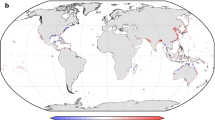Abstract
Bangladesh is frequently visited by natural disasters such as tropical cyclones, storm surges, floods, droughts, tornadoes, and “norwesters.” Of these, tropical cyclones originating in the Bay of Bengal and associated storm surges are the most disastrous. There are various reasons for the disastrous effects of cyclones and storm surges in Bangladesh. Superimposed on these disastrous effects, climate change and any consequent sea level rise are likely to add fuel to the fire. Arise in temperature is likely to change cyclone activity: cyclone intensity, if not cyclone frequency, may increase. As a result, storm surges may also increase substantially. Sea level rise, an increase in cyclone intensity, and consequent increases in storm surge heights will have disastrous effects on a deltaic country like Bangladesh, which is not much above the mean sea level. This paper examines the climatology of cyclones in the Bay of Bengal for the last 110 years and trends in cyclone frequency and intensity. The phenomenon of storm surges in the Bay of Bengal is examined along with the primary reasons for the severity of storm surges in Bangladesh. The paper discusses both qualitatively and quantitatively the impacts of rises in temperature on tropical cyclone intensity in Bangladesh. With the use of a mathematical model developed for the simulation of storm surges along the Bangladesh coast; various scenarios of storm surges are developed. Using lower and upper bounds of sea surface temperature rise of 2 and 4°C and of sea level rise of 0.3 and 1.0 m (according to the Intergovernmental Panel on Climate Change standard), the model simulates the maximum possible surges that are likely to occur under these conditions.
Similar content being viewed by others
References
Ali A.: 1980, Storm Surges in the Bay of Bengal and Their Numerical Modeling, SARC Report No. 125/80, Atomic Energy Commission, Dhaka, Bangladesh.
Ali A. and Ahmad A.AZ.: 1992, Impact of Sea Level Rise on Other Disasters in Bangladesh, presented at an IOC/UNEP Workshop on Impact of Sea Level Rise Due to Global Warming for the South Asian Region, 16–19 December, Dhaka, Bangladesh.
Ali A. and Hoque M.A.: 1994, The Journal of NOAMI, Bangladesh II(1), 27.
Bangladesh Task Force: 1990, Report of the Task Force on Bangladesh Development Strategies for 1990s, Vol. 4, University Press, Dhaka, Bangladesh.
Choudhury AM.: 1989, Forecasting and Warning System of Disaster, a SPARRSO (Bangladesh Space Research and Remote Sensing Organization) Report, Dhaka, Bangladesh.
Chowdhury M.H.K.: 1995, Critical Assessment of Tropical Cyclones in the Bay of Bengal: Bangladesh Perspective, presented at the Workshop on Global Change and Tropical Cyclones, 18–21 December, Dhaka, Bangladesh.
Chowdhury M.I.: 1959, The Morphological Analysis of the Bengal Basin, MSc thesis, University of Cambridge.
DOE: 1993, Assessment of the Vulnerability of Coastal Areas to Sea Level Rise and Other Effects of Global Climate Change, Pilot Study Bangladesh, report prepared by Department of Environment, Govt. of Bangladesh, Dhaka.
Emanuel K.A.: 1987, Nature 326, 483.
Fergusson J.: 1863, J. Geol. Soc. XIX/I, 321.
Flather R.A. and Heaps N.S.: 1975, Geophys. J.R. Astr. Soc. 42, 489.
Frank N.L. and Husain S.A.: 1971: Bull. Am. Meteor. Soc. 52, 438.
Frank W.M.: 1985, Tropical cyclone formation, in: A Global View of Tropical Cyclones, R.L. Elsberry (ed), based on the International Workshop on Tropical Cyclones, 25 November–5 December, Bangkok, Thailand.
Freeman J.C. and Mehaute B.Le.: 1964, ASCE J. of the Hydraulic Division 90, 187.
Gray W.M.: 1968, Mon. Wea. Rev. 96, 669.
Gray W.M.: 1985, Tropical Cyclone Global Climatology, WMO Technical Document WMO/TD No. 72, Vol. I, WMO, Geneva, Switzerland, pp. 3–19.
Haider R., Rahman A.A., and Huq S.: 1991, Cyclone '91, an Environmental and Perceptional Study, Bangladesh Centre for Advanced Studies, Dhaka.
Huh O.R., Ali A., and Quadir D.A.: 1985, Observations on the Surface Features in the Bay of Bengal with NOAA Satellite AVHRR Imagery, Technical Report, Baton Rouge, Coastal Studies Institute, Louisiana State University.
Johns B. and Ali A.: 1980, Quart. J. R. Met. Soc. 106, 1.
Johns B. and Ali A.: 1991, J. Marine Systems 3, 267.
Legeckis R.: 1987, J. Geophys. Res. 92, 12974.
McBride J.L.: 1995, Tropical cyclone formation, in: Global Perspectives on Tropical Cyclone, WMO Technical Document WMO/TD-No. 693, Report No. TCP-38, pp. 63–105 (reprinted 1996).
MCSP: 1992, Storm Surge Analysis, Vol. IV, Draft Final Report, Multipurpose Cyclone Shelter Programme, UNDP/World Bank/GOB Project BGD/91/025, Dhaka, Bangladesh.
Merrill R.T.: 1985, Environmental Influences on Hurricane Intensification, Dept. of Atmos. Sci. Paper No. 394, Colorado State University, Fort Collins.
Miah M.M.: 1988, Flood in Bangladesh, Academic Publishers, Dhaka, Bangladesh.
Miller B.I.: 1958, J. Meteor. 15, 184.
Author information
Authors and Affiliations
Rights and permissions
About this article
Cite this article
Ali, A. Vulnerability of bangladesh to climate change and sea level rise through tropical cyclones and storm surges. Water Air Soil Pollut 92, 171–179 (1996). https://doi.org/10.1007/BF00175563
Issue Date:
DOI: https://doi.org/10.1007/BF00175563




